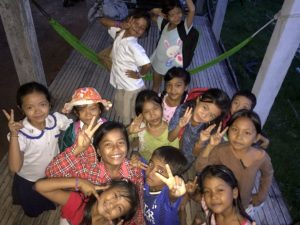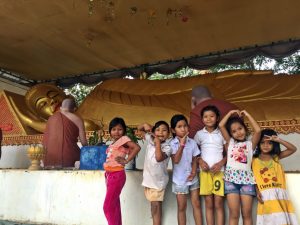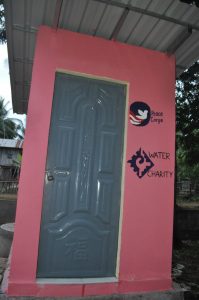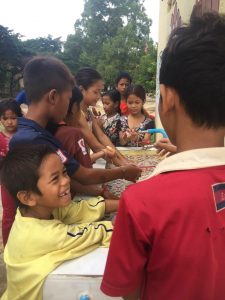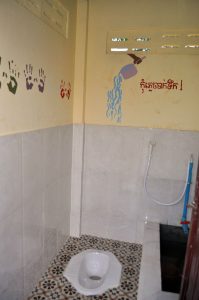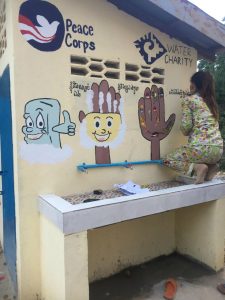This project is made possible through the partnership of WATER CHARITY and the NATIONAL PEACE CORPS ASSOCIATION. ![]()
This project has been completed. To read about the conclusion, CLICK HERE.
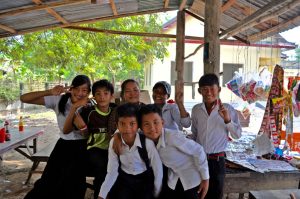 Location
Location
Prey Veng Province, Cambodia
Community Description
At the center of most villages in Cambodia lies the pagoda near a primary school. The primary school is where children, ages 4 through 14, dressed in their uniforms, begin their education. At this village in Prey Veng Province, Cambodia, the primary school has been built next to this pagoda for over 39 years. The school serves students and teachers hailing from four different villages, grades pre-kindergarten through sixth, 769 students, and 15 teachers.
Problem Addressed
At the primary school, there are currently three latrines built to serve the entire student and teacher population. However, only two toilets are open for use. The door of one of the bathrooms has rusted completely off its hinge. Additionally, the improper construction of the septic tanks, at the same level as the toilets, has resulted in its dysfunction: the toilets overflow and back-up easily.
Furthermore, the current water source – a well, which needs to be manually pumped – has proven unreliable. So, when the students want to use the facilities, often there is no water to use them hygienically, nor is there water to keep the latrines clean. A survey was distributed to teachers and students. It was found that the majority of the students found the latrines difficult to use. They attributed the difficulty to the lack of reliable water to the latrines, the dysfunctional doors, and the unhygienic state.
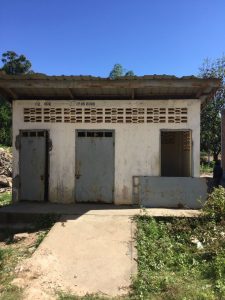 The survey also posed questions regarding the use and state of the existing handwashing station. 100% of students and teachers reported that they’ve used the hand-washing station. However, teachers detailed that it is not used habitually.
The survey also posed questions regarding the use and state of the existing handwashing station. 100% of students and teachers reported that they’ve used the hand-washing station. However, teachers detailed that it is not used habitually.
The current handwashing station is about 30 feet from the existing bathrooms, out of the way from the students’ classrooms, which is problematic in encouraging students to use these facilities. Students commented in their surveys that they attribute this sporadic use to the lack of soap at the stations and again pointed to the lack of consistent running water.
Project Description
This project is to improve sanitation at the school by restoring 3 latrines, building 3 latrines, building 2 handwashing stations, and installing a water tank and piping.
Water Charity funds will be used to purchase materials and to pay for skilled labor. The community will provide local materials, unskilled labor, and transport.
Prior to construction, in January, students, teachers, and community members will participate in a school-wide cleanup in order to prepare the land where the new latrines will be built and the old latrines repaired.
After students return from their two-week holiday for the Cambodian New Year, teachers will teach the students how to properly clean the facilities, as learned during the “Hygiene Education Week”.
Project Impact
1,180 people will benefit from the project.
Peace Corps Volunteer Directing Project
Karina Lichtman
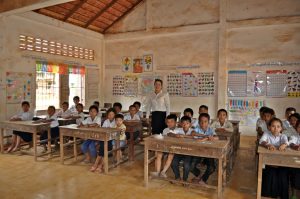 Monitoring and Maintenance
Monitoring and Maintenance
To ensure sustainability, teachers will divide responsibilities to oversee that the bathrooms remain clean and functioning. A sanitation task force, led by a grade four teacher, will oversee the schedule in place for students to clean the bathrooms daily. From there, the teacher in charge of the class cleaning on that day will be responsible to check that the latrines are cleaned and that students use the bathrooms properly.
The new water tank will guarantee the students’ and teachers’ capacity to clean the facilities properly. The counterpart and school staff will move forward with the knowledge of new handwashing training, a better understanding of students’ hesitations to use the bathrooms, and the tools to encourage bathroom use with the new sanitary conditions.
The newly created lesson plans about hygiene will allow teachers to teach these sessions in the years to come. They will have increased capacity and competency surrounding hygiene and the ways to teach this topic to their students.
Students and teachers will have the skills and knowledge to wash their hands and clean the bathrooms. They will develop these habits at school, and bring them home to their respective communities, to last them a lifetime.
Project Funding
This project has been fully funded. Your contribution using the Donate button below will be used to fund future projects in Cambodia.
Funds raised in excess of the project amount will be allocated to other projects in the country.
Conclusion of Prey Veng Province Latrine Project- Cambodia
This project has been completed under the direction of Peace Corps Volunteer Karina Lichtman. To read about the start of the project, CLICK HERE.
The project was designed to improve sanitation at the school by restoring 3 latrines, building 3 new latrines, building 2 handwashing stations, and installing a water tank and piping.
Karina reports:
Project Summary:
Over the course of a short 5 months, the Water Charity: Sabbay Sanitation Project was born, ran its’ bumpy course, completed, and evaluated. Affecting 769 students from 5 different villages and 14 teachers, PCV Karina and her counterpart Sum Kim Seng, enlisted the community’s support in building 3 new bathrooms, 2 new hand-washing stations, and restoring the existing 3 bathrooms, and 1 hand-washing station, as well as build a 2,000-liter water tank, to ensure a consistent supply of running water at the school.In conjunction with the construction, this project served to educate students at the school, in an effort to build a habit of hand-washing through a skit performed by high school student volunteers, and through 3 lessons carried out by the teachers, as well as 1 pledge, promising their commitment to hand-washing at critical hand-washing times.
Prior to, and post-construction, students, teachers, and the PCV carried out “porlekham”, which translates to cleaning up the school – picking up garbage, sweeping outside the classrooms, and digging up dirt surrounding the perimeter of the school, to ensure the grounds do not get flooded during this rainy season.
A “Sanitation Task Force” (STF) was formed, consisting of 3 teachers and the school director, to create lesson plans focused on hand-washing education. This task force carried out 2 teacher-training sessions, to ensure a complete understanding of the new activities created. The STF also led the staff in ensuring sustainability, assuming responsibilities to oversee the new facilities are well kept and respected.
Students and teachers are now equipped with the facilities and knowledge to maintain good health and hygiene while at school, providing an environment conducive to learning.
Goals Achieved, Changes in Initial Objectives, and Community Feeling:
From the students at the high school, to teachers and students at the school, to their parents, this project affected many communities.While I was painting the murals outside and inside the bathrooms, many students watched. A male student in grade five in particular talked about his excitement for the new bathrooms, and the new hand-washing stations. He talked about how in the past, many students would get sick from what he guessed was because there was no soap to wash their hands, and they would return home and have not come back to study since. He guessed that they were not “hee-in” (brave/daring/willing to take the risk) enough to return to their studies. Now, with the new hand-washing stations, and the supply of soap, he was excited to never have to worry about himself getting sick, because he’d have the facilities, (and the knowledge!) to keep himself clean.
Teachers at the school have expressed their gratitude for this latrine project. Parents who come to pick their children up have also expressed happiness at this new construction. Many of the parents of students who study in kindergarten watched the high school student volunteers perform the SuperAmma skit. They lined the windows and left with their children smiling.
Despite the challenge of our budget being off, the community has expressed great appreciation of the project. Teachers reported the success of their lessons in class, and the students’ enthusiasm learning the lessons. A grade 5 teacher reported she saw some of her students playing the hygiene education games during the Khmer New Year, at the pagoda, and also during the students free play time.
Our project was able to adhere to the goals and objectives laid out, and we fulfilled them accordingly. In our teaching training sessions, we discussed adjusting the education focus and evaluation of the students’ ability to clean the bathrooms to grades 4-6, as these students are the ones to be responsible for cleaning the bathrooms. In our assessment, we found 90% of students answered the questions regarding bathroom cleaning correctly.
According to our assessments, 60% of our students correctly answered questions regarding at least three critical hand-washing times. Upon reflection of our hygiene lessons, the lessons focused heavily on hand-washing after using the bathroom, and before eating. 95% of the students listed these two critical hand-washing times. 5% of students were able to name: after cleaning up their baby sibling after he/she defecates, before caring for their sibling, and/or before preparing food in addition.
99% of students were able to demonstrate proper hand-washing techniques when practicing and throughout the lessons. Teachers reported students have also demonstrated proper hand-washing techniques in class when asked. On the assessment, the students were able to answer correctly as well. The 1% accounted for 1st grade students who struggled with this.
Sustainability:
Teachers have assigned themselves roles to oversee the longevity of the bathrooms and hand-washing stations.Mr. Phanet, who lives across the street from the school, is responsible for pumping the water into our two water tanks. These tanks will always be filled with water, and the water will flow during school hours, so as to ensure good hygiene of the students and bathrooms.
Ms. Socheata will be responsible of ensuring there is always soap at the hand-washing stations. All students will be responsible to contribute a small amount of money, around $0.02, to purchase soap for the school. Each class will be responsible for one month of soap, presumably 10 bars of soap (1 for each hand-washing station, 2 at the old hand-washing station, 1 placed inside the teacher’s bathroom), which costs $0.50 per bar. The soap will then be distributed to the soap holders, which were made by Ms. Socheata, secured at the hand-washing stations so that students will always have soap.
Teachers organized a daily cleaning schedule for the bathrooms. Students in grades 4 through 6 are responsible for cleaning the bathrooms. There are two 4th grade classes, two 5th grade classes, and two 6th grade classes, equating six classes total. Each class will be responsible for 1 bathroom. Groups of 3 students will clean their designated bathroom in the morning/check to make sure there is enough water in the basin for the day, and another group of 3 students will check their designated bathroom in the afternoon. The fourth grade teacher is responsible for checking to ensure the bathrooms are cleaned, and the teacher of each class will ensure that the students in each group clean on their designated date.
The school director is in charge of checking the electricity at the school, and to maintain that the pump, which depends on electricity, will work when needed. The electricity in our community is reliable, and will allow us to pump water when needed.
Check out these videos:
Blessing Construction Site
6th Grade Students Making Pledge 1
6th Grade Students Making Pledge 2
Super Volunteers Skit
We extend our thanks to Karina for completing this important project.
